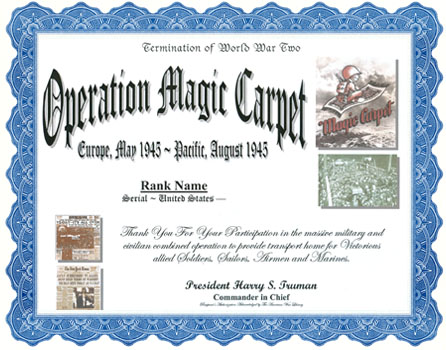

So until Japan was defeated, the process of ferrying GI’s westward home would be the sole responsibility of the Army, Coast Guard, and the Merchant Marine. Noticeably absent from this nascent plan was the US Navy who, faced with the task of preparing for the likely invasion of the Japanese Home Islands, was unwilling to relinquish any of their force of attack transports and warships for transportation roles. Where would troop collection assembly points and processing centers be set up in Europe? What American ports and rail networks were large enough and available to support the influx of returning troops that could then swisk American soldiers inland to separation centers and back to civilian life? And whose ships would be used to bring the boys back home?Īs part of the pre-Magic Carpet plan, the WSA, in control with its vast armada of cargo carriers, the Army and its wartime fleet of troopships, and the Coast Guard with its force of assault troopships, would be the primary vehicles available to transport American servicemen back home to ports on the East Coast once Germany was defeated. Following D-Day, when it was predicted that the war in Europe would end within six months, Marshall and his team had more questions than answers. If World War II was a game of Monopoly, the WSA was the bank.Īs early as mid-1943, even though Germany and Japan had yet to be defeated, US Army Chief of Staff George Marshall recognized that once victory in any theater was secured, redeployment and demobilization could and would present a major obstacle if preliminary planning was not begun.

That is, the WSA and its attendant organization, the US Maritime Commission, which were coincidentally headed by the same man, Admiral Emory Land, would tell the Army or Navy which Liberty or Victory ships, transports, and/or civilian craft were to be earmarked for their usage. Established by President Roosevelt in February 1942, to deal with the shortage of civilian shipping tonnage available for use by the US military, the WSA, to quote the Executive Order which authorized its creation, was to ‘control the operation, purchase, charter, requisition, and use of all ocean vessels under the flag or control of the United States’ as well as ‘allocate vessels under the flag or control of the United States for use by the Army, Navy, other Federal departments and agencies, and the Governments of the United Nations.’ Dorothy Poitevent, 2007.243.295.Įven though ships, supplies, personnel, and planning from all branches of the military would be needed to execute Magic Carpet successfully, at the head of its organizational development was the War Shipping Administration or WSA. The sum total of which provides the mathematical framework behind the beginning of the post-war Baby Boom nine months later.ĭoctors returning to the United States in the Mediterranean or Atlantic circa October 1945, The National WWII Museum, Gift of Ms. On average Operation Magic Carpet transported 22,222 Americans home every day for nearly one year straight. Though on some days and months, particularly December 1945, the return rate was much higher. Operation Magic Carpet officially commenced on September 6, 1945, four days after VJ-Day ending on September 1, 1946.

Though lasting only 360 days, Operation Magic Carpet was the largest combined air and sealift ever organized. However, it is when the sheer volume of Americans returned are considered-eight million men and women from every service branch, scattered across 55 theaters of war spanning four continents-that one can make the case that Operation Magic Carpet stands as one of the greatest achievements of the entire war. That it was a global experience shared by millions makes it remarkable enough on its own. Separated by vast distances, theater, branch of service, sex, race, and rank, the journey home to the United States at the conclusion of World War II was one of only a handful of incidences universal to nearly all American servicemen who fought and survived the bloodiest conflict in human history.


 0 kommentar(er)
0 kommentar(er)
